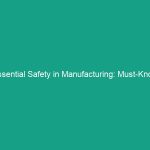Good Morning Team!
Today, we are going to discuss a crucial aspect of our Workplace Safety: Essential Team Accountability for Safety. It’s vital that each of us understands our role in maintaining a safe work Environment. When we talk about accountability, we’re not just discussing personal responsibility; we’re delving into how each of our actions impacts the Safety and well-being of our entire team.
Understanding Essential Team Accountability for Safety
So, what exactly is Essential Team Accountability for Safety? At its core, it refers to the collective responsibility that every member of a team holds in ensuring safety protocols are followed. This concept emphasizes that safety is not solely the duty of supervisors or safety officers but is a shared responsibility among all team members.
When team members hold each other accountable, they create a culture of safety where everyone feels empowered to speak up about Hazards, suggest improvements, and ensure compliance with safety Standards. This culture not only enhances safety but also boosts morale and teamwork.
Many employees mistakenly believe that accountability means blaming others when things go wrong. In reality, it’s about fostering an environment where everyone is encouraged to take ownership of their actions and support one another in making safe choices.
Key Hazards, Risks, and Safety Considerations
Let’s take a moment to identify some common hazards and risks associated with a lack of accountability in Workplace Safety:
- Failure to Follow Protocols: When team members do not adhere to established safety Procedures, it increases the likelihood of accidents and injuries.
- Complacency: Without accountability, employees may become complacent, ignoring Safety Measures that they perceive as unnecessary.
- Poor Communication: A lack of accountability can lead to misunderstandings about safety responsibilities among team members.
- Inadequate Reporting: Employees may be less likely to report near-misses or unsafe conditions if they do not feel a sense of accountability.
Ignoring safety protocols can lead to serious consequences, including injuries, legal ramifications, and a negative impact on team morale. It is crucial that we recognize these risks and take proactive steps to mitigate them.
Best Practices, Procedures, & Actionable Advice
Now that we understand the importance of accountability, let’s look at some Best Practices that can enhance our safety culture:
1. Establish Clear Roles and Responsibilities
Every team member should know their specific safety responsibilities. This clarity helps everyone understand their role in maintaining a safe workplace.
2. Foster Open Communication
Encourage team members to voice safety concerns without fear of retribution. Regular safety meetings can provide a platform for discussing potential hazards and solutions.
3. Conduct Regular Training
Provide ongoing training to ensure everyone is up to date on safety protocols and procedures. This should include refresher courses and hands-on training sessions.
4. Lead by Example
As leaders and colleagues, we must model safe behavior. When team members see others adhering to safety protocols, they are more likely to do the same.
5. Implement a Peer Accountability System
Encourage team members to hold each other accountable. This can include simple check-ins or reminders among colleagues about safety practices.
6. Recognize and Reward Safe Behavior
Positive reinforcement can go a long way. Recognizing team members who consistently prioritize safety can motivate others to follow suit.
Regulations, Standards, and Compliance
Understanding Regulations is a key part of ensuring team accountability for safety. Compliance with standards set by organizations like OSHA (Occupational Safety and Health Administration) is critical for protecting each employee’s well-being. Here are some relevant points:
- osha mandates that employers provide a workplace free from recognized hazards, which requires teamwork and accountability.
- Regular safety audits should be conducted to ensure compliance with both federal and local safety regulations.
- Fostering accountability aligns with ISO (International Organization for Standardization) standards, which emphasize continuous improvement and risk management.
Non-compliance can lead to fines, penalties, and, more importantly, jeopardize the safety of our team members. It’s essential that we all understand the rules and do our part to uphold them.
Employee Engagement & Discussion
Now that we’ve covered a lot of ground, let’s engage in a discussion:
- What safety challenges have you encountered related to accountability?
- Can you share an example of a time when accountability prevented an accident?
- What suggestions do you have for improving our team’s accountability regarding safety?
Your insights are invaluable in shaping our safety culture, so please feel free to share your thoughts!
Conclusion & Key Takeaways
In closing, remember that Essential Team Accountability for Safety is not just a concept but a practice that can significantly enhance our Workplace Safety. By understanding our roles, communicating openly, and holding each other accountable, we can create a culture where safety is a priority for everyone.
Let’s commit to applying these practices daily and encourage each other to prioritize safety. Thank you all for your attention and your ongoing commitment to keeping our workplace safe!


